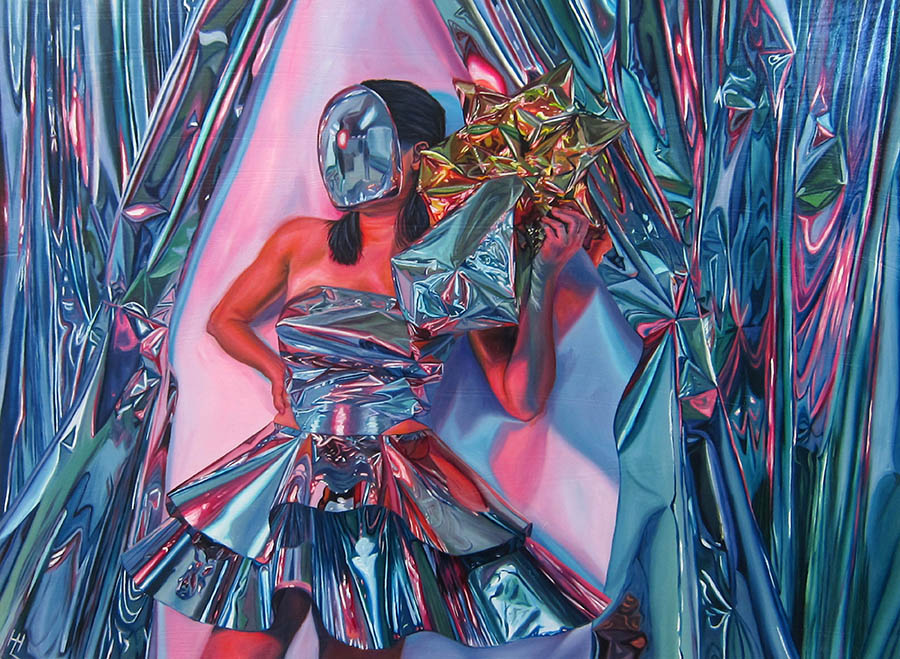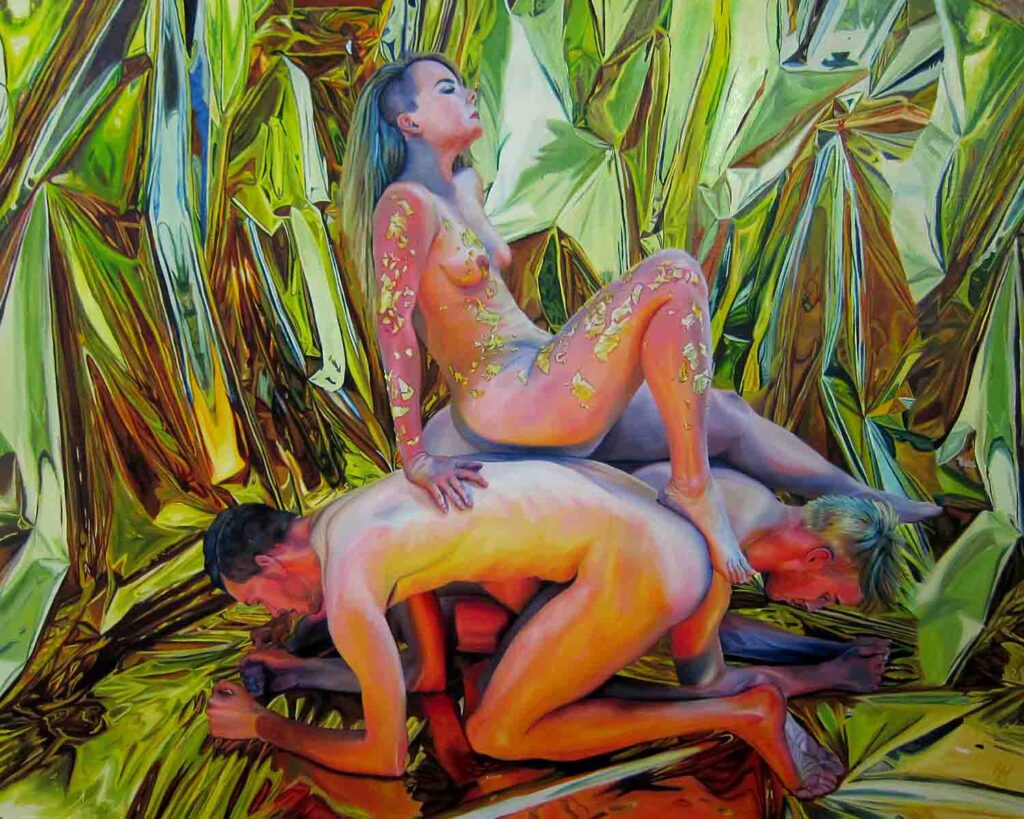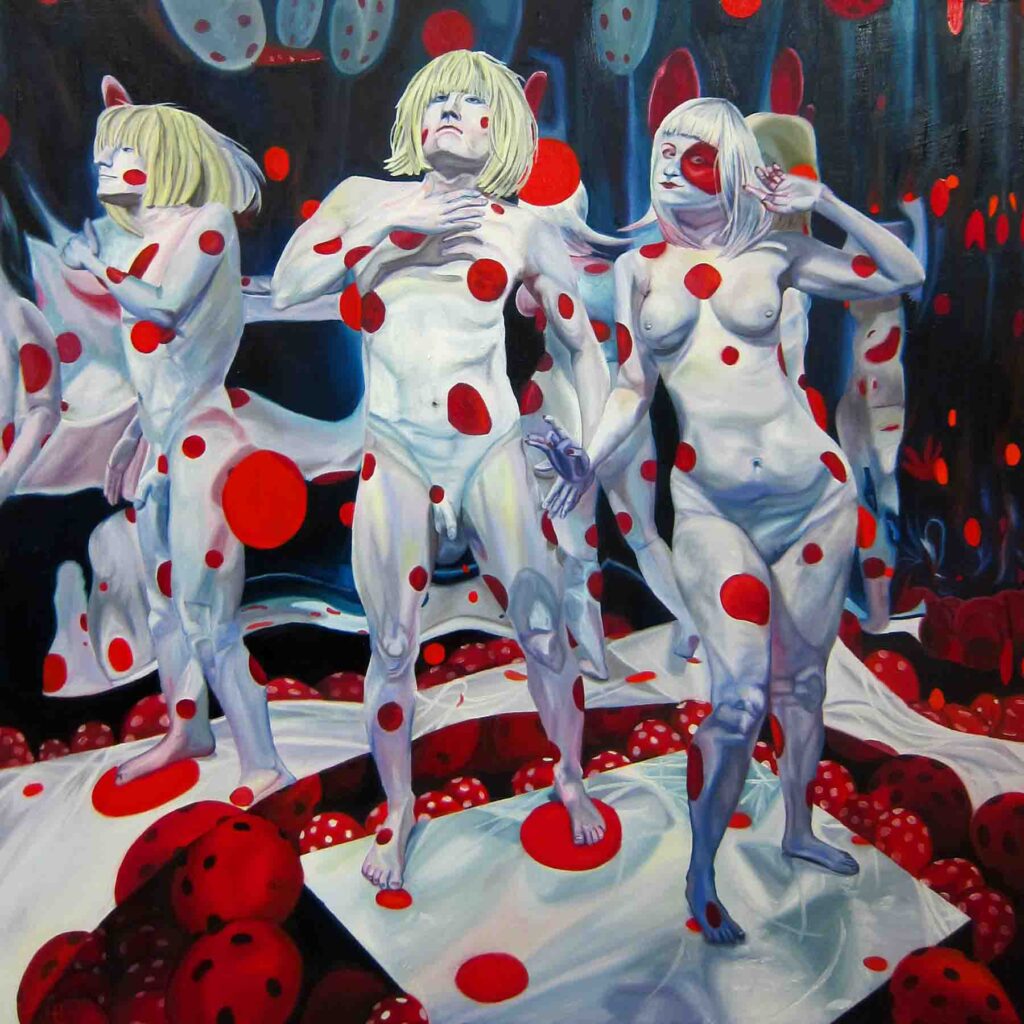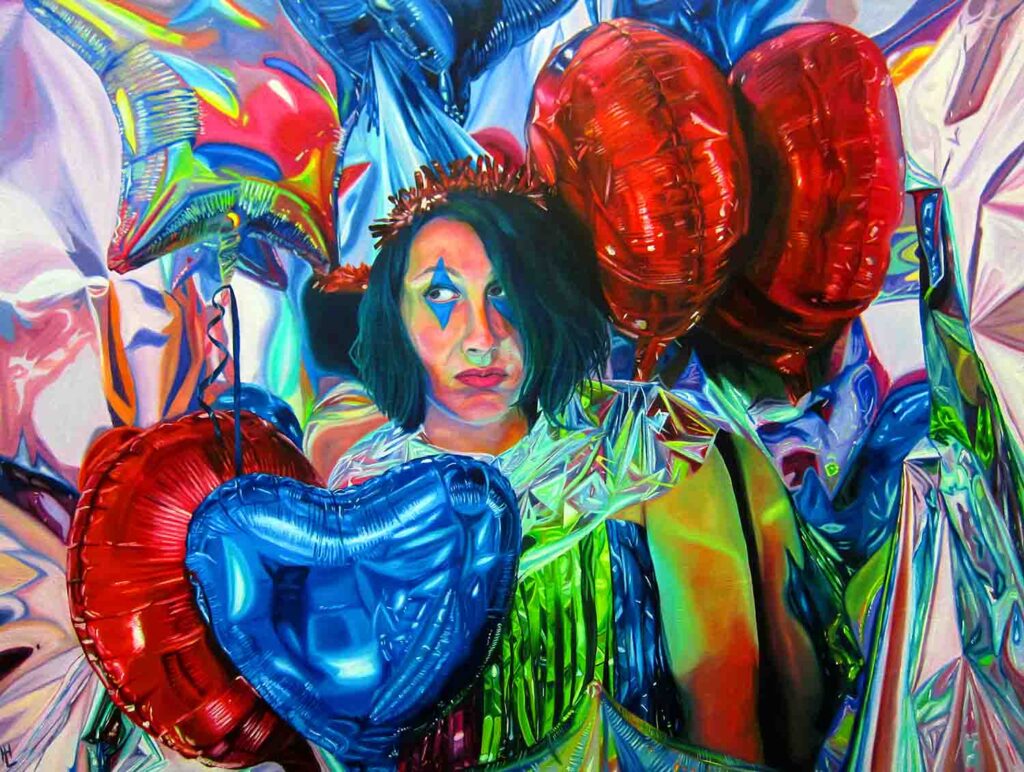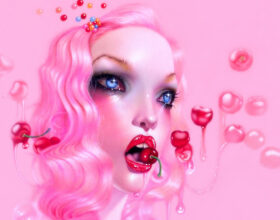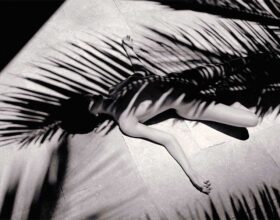It goes against our nature to seek out what frustrates and challenges us. But rather than settle where she felt most comfortable, figurative painter Heather Heitzenrater set her sights on mastering the one subject that at first eluded her. Now, after years of study and practice, the reflective surface is a hallmark of the Pittsburgh-based artist’s work. Although the primary focus of each composition is often a photorealistically-rendered nude form, what gives her paintings their distinctive surrealistic mood are the draped sheets of Mylar in the background.
When light hits mylar’s surface, it bends and distorts the colors and shapes around it, a characteristic that Heather Heitzenrater exaggerates to an uncanny degree in her work. Through the use of heightened colors, uniquely-shaped canvases, and deeply emotive expressions, she invites you into the mystical world of her imagination to explore fantasy and the art of painting itself.
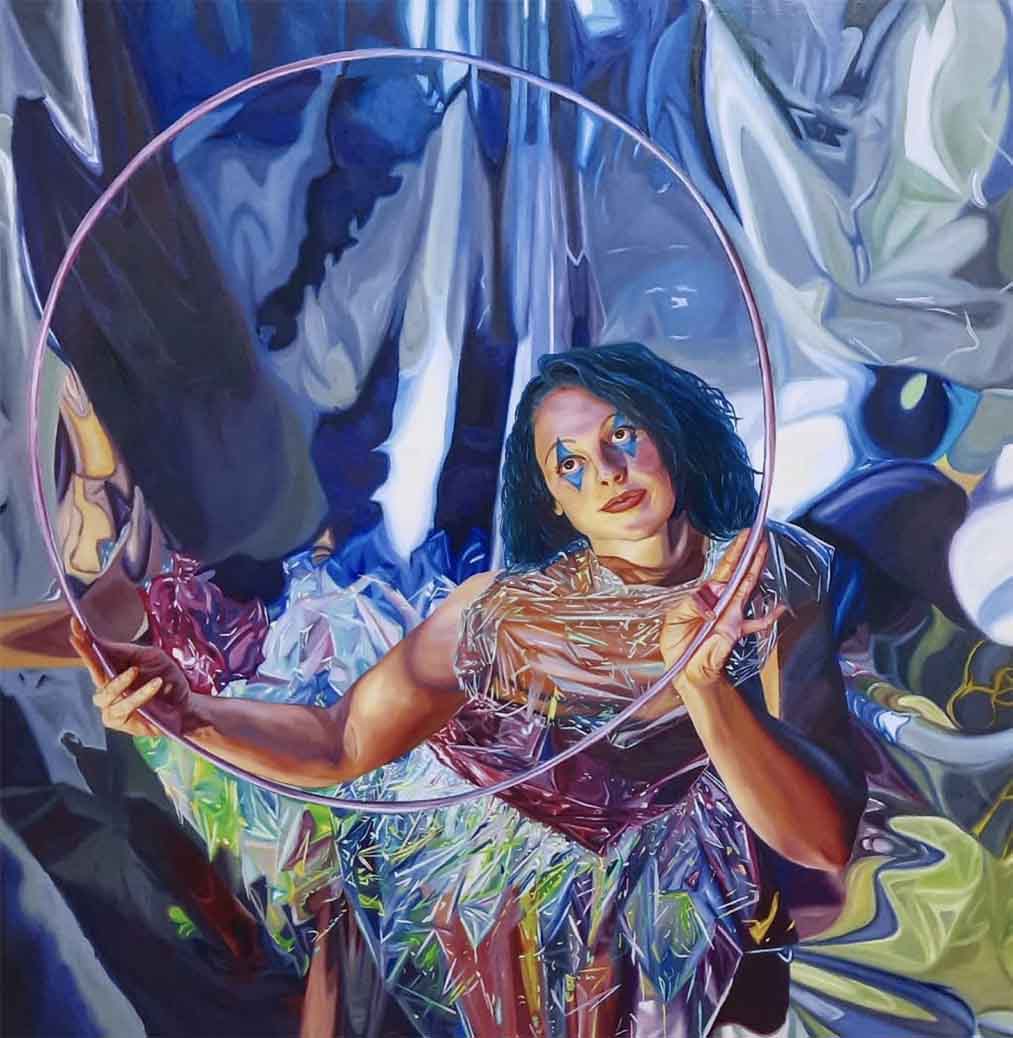

Exclusive Interview with Heather Heitzenrater
I learned from a previous interview that you grew up drawing around your grandmother’s kitchen table with your cousins. Can you share more about these memories? What do you remember creating and what was it like to have this shared interest and support with making art from a young age?
I remember the first time using paint. It had glitter in it! I kept asking for it every time I went over to my grandparent’s house. That initial painting hung on my mom’s fridge until it fell apart. They also kept a sketchbook and colored pencils on top of the fridge. Everyone would draw in it. Even my aunt and uncles! Being creative was always encouraged and seemed like second nature in my family. My mom made the hallway of the house my little art gallery and it stayed like that until I left for college.
Critiques were always rough as well. I think movies and TV also always make it seem like you can get away with anything in art school and people call you an artistic genius. Whereas in my case, I left most feeling defeated or crying (although they made me want to do better).
When it came time to go to college, you knew you wanted to study art. Were you also certain about concentrating in painting and drawing or did you experiment with other mediums?
When I went to college, I had no idea what I wanted to concentrate in. I liked everything! For a while, I was very gung-ho on going for costume design. Then I realized I didn’t care too much for sewing. I figured drawing was a good baseline to start since everything starts with a drawing. For my BFA at Edinboro University of Pennsylvania, everyone has to take an intro class to every art concentration. I was thinking of painting as a minor. Not going to lie, painting was tricky for me at first, but near the end of my painting 101 class I was hooked, and I made my major painting and my minor drawing.
Is there a stereotype about art school that’s completely true? What about one that most people falsely believe?
Art school is HHHAAARRRDD. A lot of other students would say to me, “It must be nice to color all day”, but you put in so many hours and you don’t have a lot of time to socialize like other majors do. I went to a state school for my art education so I still had to take general elective classes in addition to my art courses. Critiques were always rough as well. I think movies and TV also always make it seem like you can get away with anything in art school and people call you an artistic genius. Whereas in my case, I left most feeling defeated or crying (although they made me want to do better).
One of your primary series, Thresholds, was an idea that you began working on in your junior year. Can you share more about the genesis of this body of work and what you explore in it?
With Thresholds, I was looking for an escape from the mundane. It has just opened a rabbit hole for me that I feel like I will never get tired of exploring. It mostly started with me trying to incorporate reflections, color, and the figure into my own unique style. Every time I think I am done with the series I have another idea, or it branches off into another vein. For me, it tells a story about how I process current events or personal growth. It’s like how fantasy and science fiction stories are metaphors for issues in society.
What are other series you’ve worked on since graduating?
Honestly, it’s all been a branch off Thresholds. Thresholds is like the middle ground to the story. I did a brief series called Gateway that was the prequel to Thresholds. It was more mundane and grimier. Additionally, I have one called Imaginarium, which is more about going further into the world of Threshold. It’s more fun and wonder-based. I also have a separate series called Goddess that explores Greek myth with feminist movements of today. The backgrounds are all gold and they have several figures in them. Finally, I have a fun, abstract series called Lost. This includes small, shaped panels that only focus on mylar. They are my #1 bestseller.
You mention in your artist statement that you enjoy the science fiction and fantasy genres. Any favorite books or movies? How has love of the whimsical, surreal, and supernatural impacted you creatively?
My all-time favorite movie is Jim Henson’s Labyrinth. I feel like that movie really started my love of finding another world and all things whimsy and creepy. I also read the Chronicles of Narnia books over and over. I think my copy of The Magician’s Nephew is falling apart. As I got older, Erin Morgenstern’s Night Circus really did it in for me. I never fell in love with a book so much before. had a reading hangover for three years after that one. I’m also a huge Whovian. I just love the feeling these stories give me. They make me want to strive to make worlds like these on my own so I can stay in them for a little while longer. I usually listen to an audiobook with the same vibe that I want my painting to have to keep me in the same headspace.
Upon completing your degree, what did you do to start putting your work out there and building the foundation for your art career?
I did every little show that came up and applied to everything that I thought was a good fit for my work. During my senior year of college, my professor wanted me to still work on small studies. I was tired of doing small works and wanted to create a big series of work that I could submit to a gallery for a ready-to-go show. It worked! I got a show and gallery representation shortly after college. It took around five years for my artwork to start to steadily sell. The more you show it around the more people will want to buy it.
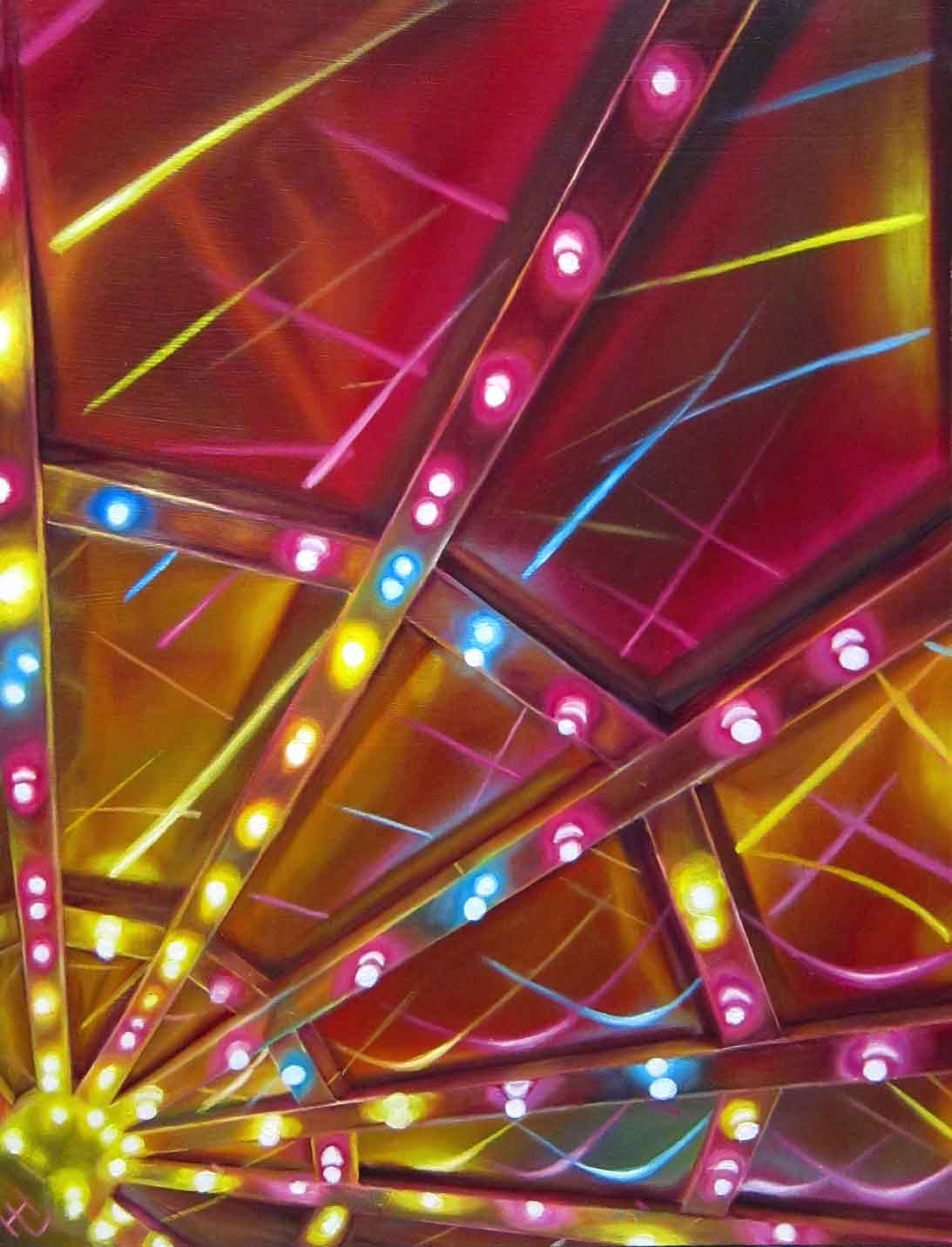
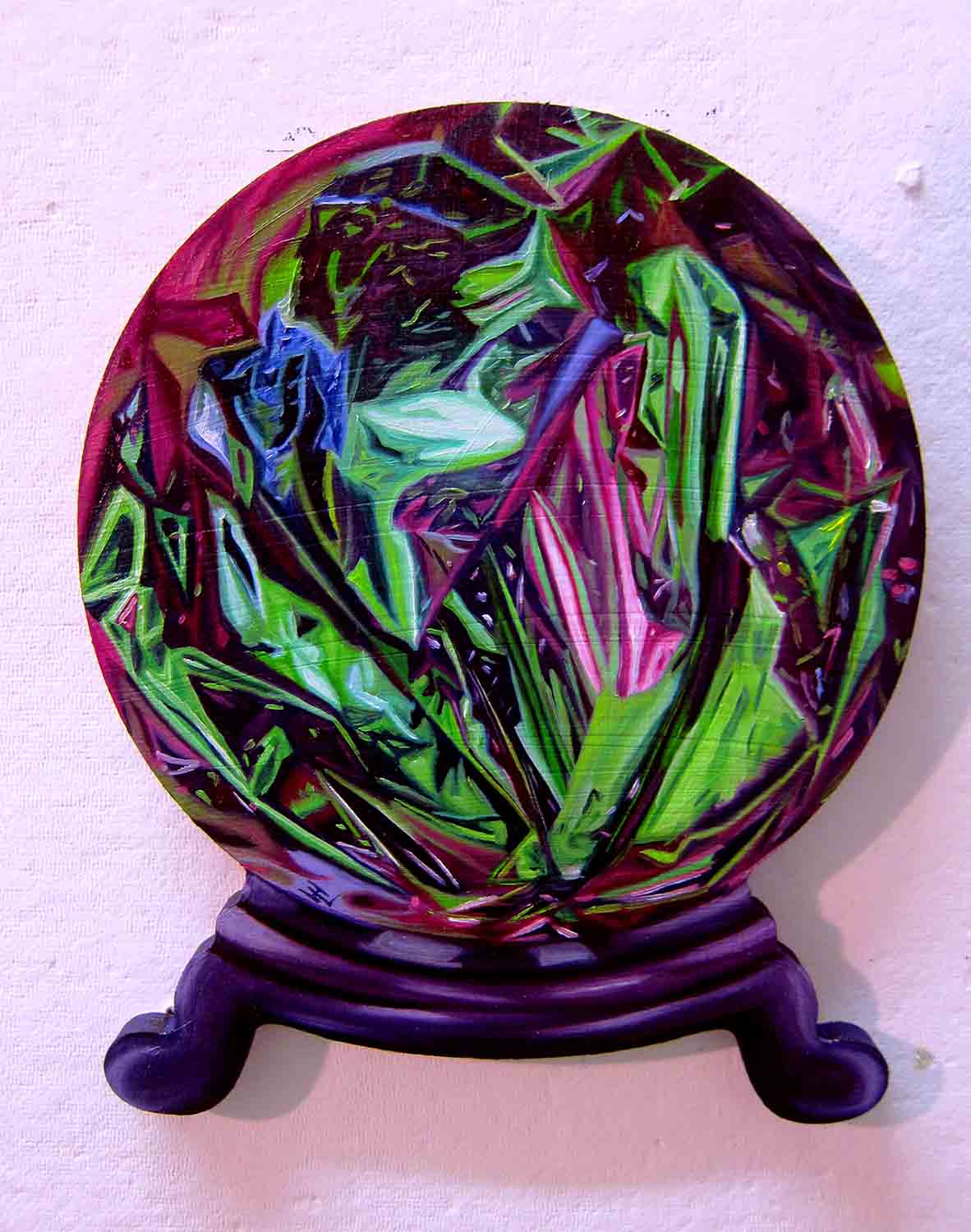
Were there any resources you found particularly useful during this time?
Sooooo many podcasts. Like Catherin Orer’s Artist Entrepreneur Podcast. John Dalton’s Gently Does It. The Create! Podcast and I Like Your Work Podcast. Some great books that helped me were The Artist’s Guide by Jackie Battenfield and anything by Bridgette Mayer. The Complete Smartist Guide has been a game-changer and a lot of artists on Instagram give good tips on making an art business as well.
What are your techniques for achieving the level of realism that you do in your art? Are they based on the foundational drawings, details, shading, layering, or something else?
I took every scientific art class my school offered. I took human anatomy drawing twice because I loved it so much. Having a good understanding of the human body is important. You could be a great painter but if your anatomy or perspective is off in the figure, it is going to show. I use synthetic brushes to help me blend my colors and tend to work in thin layers that I slowly build up. Value and color temperature are also key in creating realism. I make sure I have high-quality paints to get the brightest colors I can and utilize picture references as well. When you work with photographs, remember that they are just a tool. Cameras tend to kill all of the subtle colors you see in real life. They also skew proportions so always be aware.
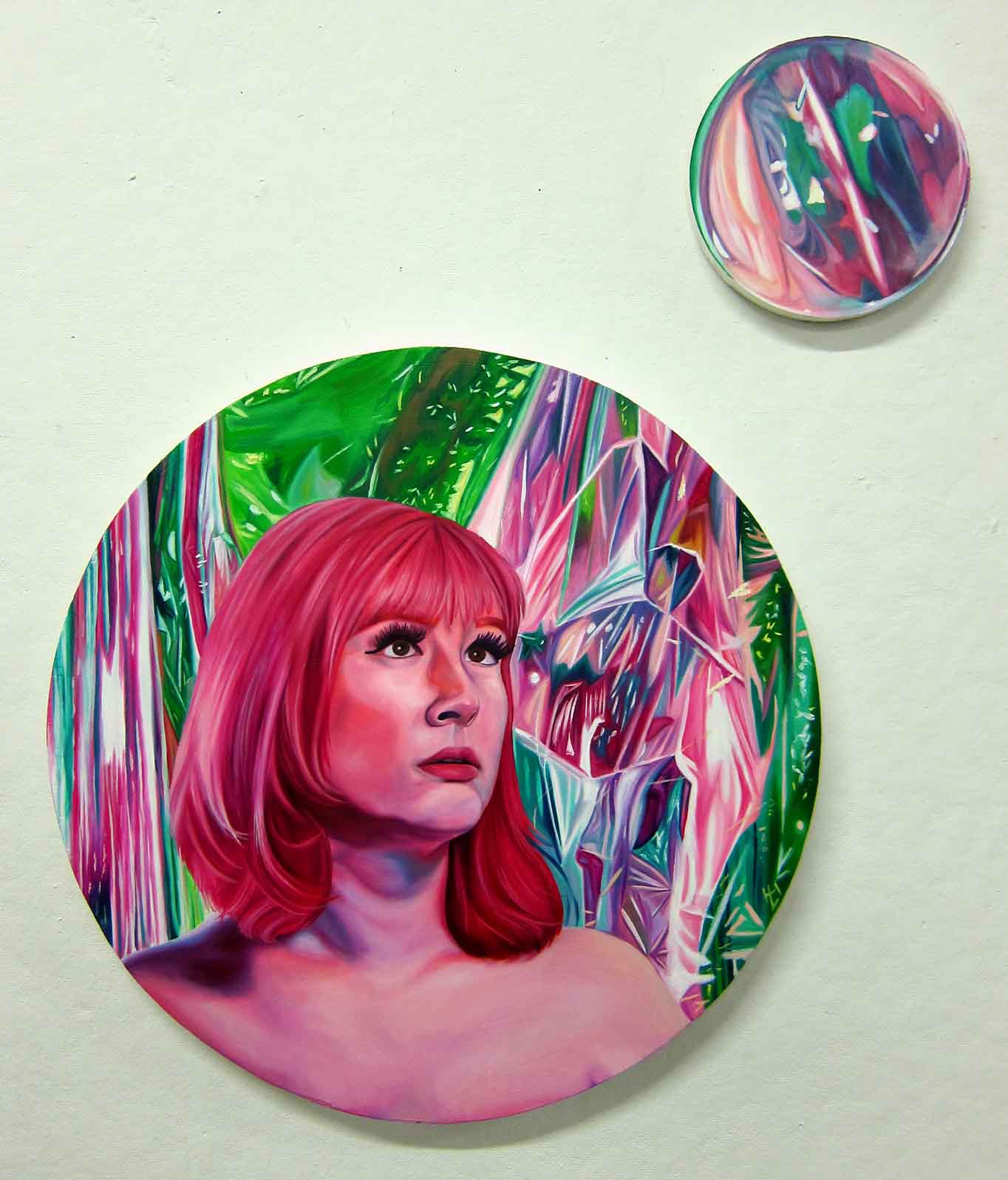
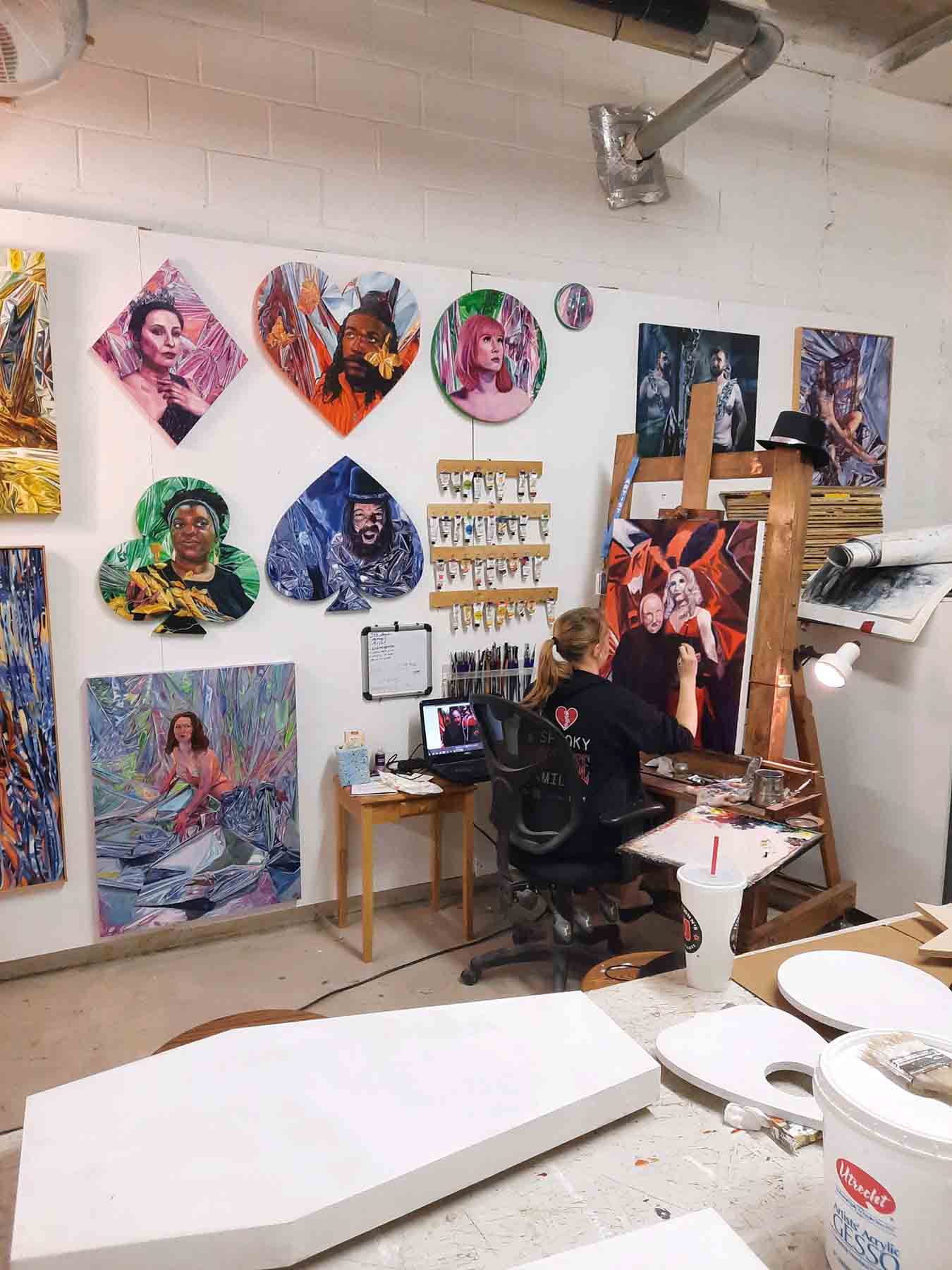
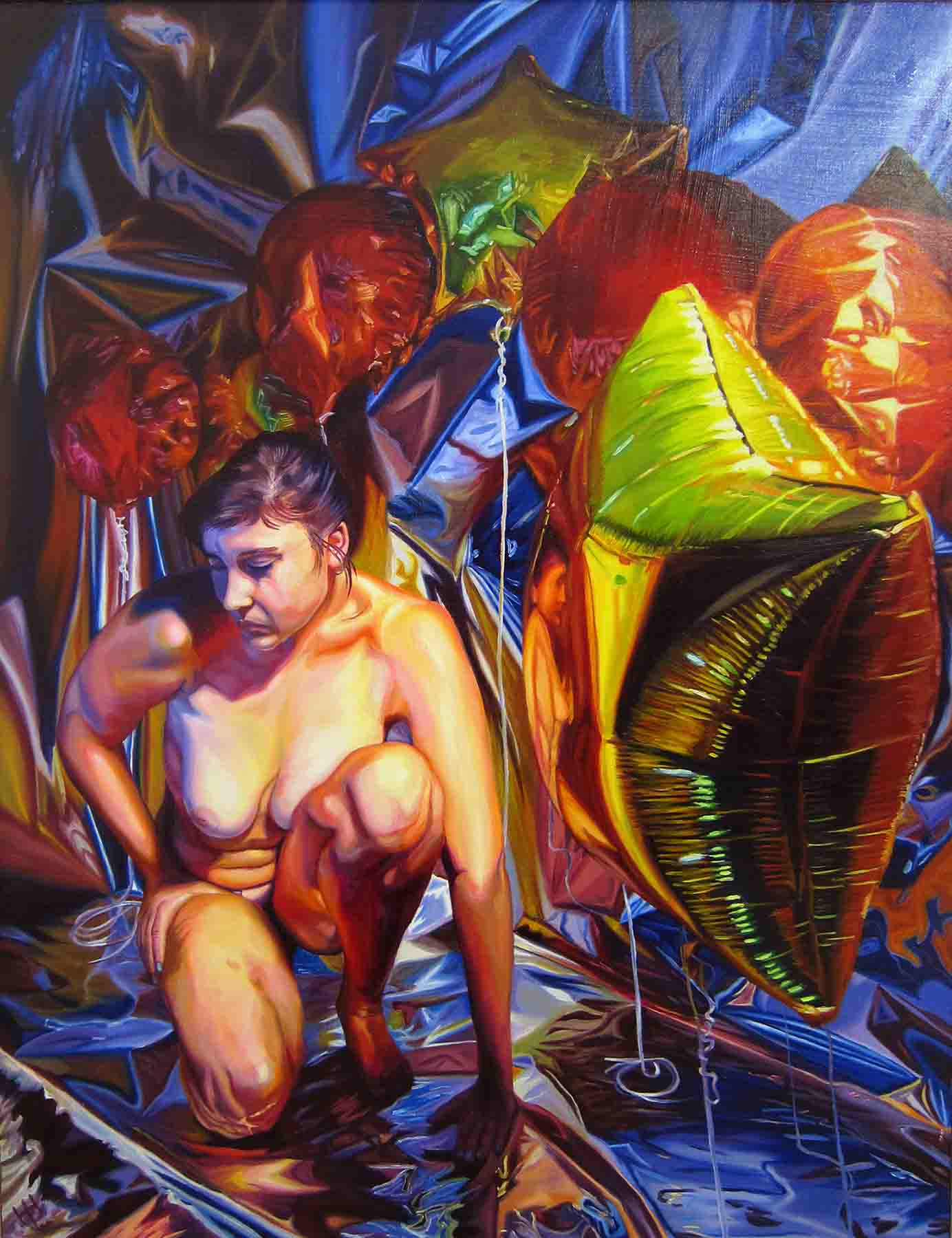
When you work with photographs, remember that they are just a tool. Cameras tend to kill all of the subtle colors you see in real life.
Along the same lines, I’m interested to hear more about some of the challenges of painting reflective surfaces like mylar!
I started painting reflective surfaces in my first painting class. It drove me bonkers that I could not do it. So, I made it my focus. I painted glass bottles, tin cans, and foil balls. I then moved on to painting my friends underwater. But at the time, there were a lot of people painting water so I wanted to find something different. I stumbled across reflective mylar and bought a 100 ft roll. I used to paint it from life, but it is very difficult. If you move, or it moves, or the light changes, it looks completely different. I started to take pictures of it. In doing so, I soon realized that when you shine colored lights on mylar and take a picture, it changes its look completely!
When I first started painting mylar, it would give me a headache. So much was going on! So, I break it down into big color shapes then I go in and do the details. I also realized that I don’t have to paint every color and line that I see in the mylar. If I do, the painting becomes too busy. Highlights are the main thing that makes something look reflective. I always add them last once most of the paint has dried so they really pop!

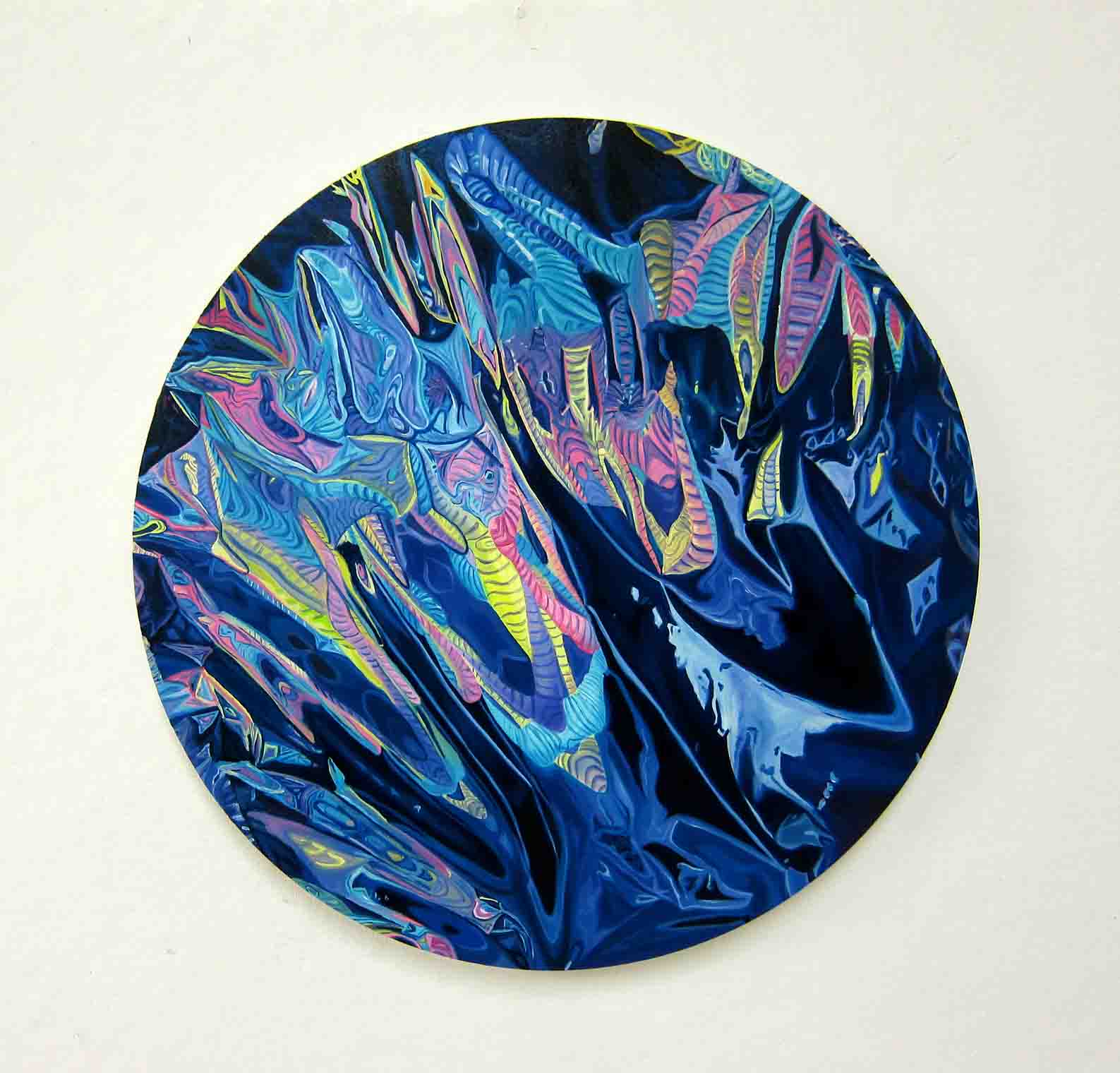
Highlights are the main thing that makes something look reflective. I always add them last once most of the paint has dried so they really pop!
Are there any other technical skills as an artist that you’re working on developing?
I got a jigsaw, and I am learning more carpentry skills so I can make interesting and unique shaped panels to work on. I’m trying to move away from academic standards of art and find more fun in it to make my inner child happy.
You share a studio with your husband, who is also an artist. What is it like to have a creative partner and do you critique each other’s work?
I love it. We share a big studio. If we seem stumped on a new idea or need someone to do a quick critique, we can just turn around a talk it through. We aren’t always at the studio at the same time, so it is nice when we are there together. The studio can get lonely sometimes!
Beyond painting your own fine art, you also are a scenic artist and lead drawing workshops. In what ways have these other creative roles supported your personal work?
I am the Scenic Coordinator at a haunted house. It’s the most fun job in the world, but also the most stressful. I mostly work there in the summer and for part of the fall. During this time, I don’t get a lot of studio hours. However, I do get a ton of ideas while I am at the haunt. It’s also a cool place to take photo shoots for future paintings so it really works hand in hand with my art practice. Additionally, I get to learn a lot of new techniques every year that I can take back to the studio.
Teaching figurative workshops also keeps my drawing in check. Sometimes I can get in a bad habit with figure drawing, or I forget about something. When you teach, you are always reviewing the information and making sure you practice what you preach.
What will you be working on in 2022?
Right now, I have a ton of new ideas I want to explore since the haunt-building season is calming down. I want to start a new series called Funhouse. But first I need to finish up a few commissions and get ready for my solo show at BoxHeart Gallery in February. I want to try a few new mediums in my work that art school told me was “tacky” like fluorescent and metallic paint, and glitter. I want my work to be more lighthearted and make people happy while still having that touch of dark allure and mystery to it.


